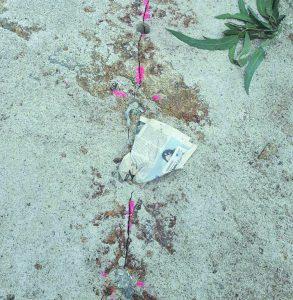
THIS IS HOW THE EXPANSIVE CEMENT ROAR WORKS
- The cement must be used in holes; pouring it into existing cracks in the stone or rocane will be effective.

- Safety glasses must be worn at all times by personnel in the area. Helmets and safety boots are a good idea in any construction or demolition site.
- When using the temperature table, keep in mind that the temperature of the hole can be much higher than the temperature of the surrounding air if it is in the sun or affected by a nearby heat source due to machinery or by drilling the holes.
- Low temperature, hard stone, or holes that are too far apart can lengthen the breaking time. If after a full day no crack appears, wait a bit before thinking about an error in the mix. ROAR EXPANSIVE CEMENT continues to press for 24-48 hours.
- If when mixing the EXPANSIVE ROAR CEMENT it starts to emit steam in the bucket, add 2-3 liters of water, remove, clean and throw the mixture in the trash. This happens because too much time has passed since the beginning of the mix.
- If smoke or steam begins to fill in the holes, this is a sign that the mixture may burst. Immediately clean the area of people. Vapors are not dangerous or toxic in any way.

¿WHAT CAN CAUSE A REBENTON?
- Use a hole with too much diameter.
- Use too hot water in the mixture. See table of temperatures.
- Use very little water, especially when the stone or cement is at a temperature above 22ºC.
- Too much time elapsed between the beginning of the mixture and the filling of the holes with said mixture.
- Guess the interior temperature of the hole instead of measuring it.
- Guess the temperature of the water instead of measuring it.
- Holes that are very shallow. The depth must be 4 times the diameter of the hole or more.
- Allow the powder to be too hot before mixing it with water.
- Holes drilled very close, 25 cm, in soft stone or cement, in a hot weather.
- The best diameter of the drill is 38 mm
- Blows normally do not occur after 3 hours after filling the holes..
MANIPULATION AND STORAGE
Precautions for safe handling.
- Do not handle or store near food, drinks or tobacco.
- ROAR EXPANSIVE CEMENT is a highly alkaline product, the pH reaches 13 after contact with water and can cause strong irritations to the mucous membranes, especially to the eyes.
- Wear safety goggles, rubber gloves and helmet during the process of mixing and pouring the EXPANSIVE ROAR CEMENT.
- Wear a dust mask when using EXPANDIVE ROAR CEMENT, especially in areas where ventilation is scarce, such as tunnels or mines.
- Do not be close and especially not close your head for at least 3 hours after filling the holes
- Keep people away from the area after filling the holes.
- Cover the holes of the rain or direct sunlight with just a rag or tarpaulin that does not accumulate heat
- The skin contact with ROAR EXPANSIVE CEMENT must be removed with large amounts of cold water quickly after contact.
- The contact with the eyes of the EXPANSIVE ROAR CEMENT must be eliminated with large quantities of cold water immediately and without rubbing. Consult a doctor quickly.
- Keep out of the reach of children.
CAUTION NOTE
- The expansive demolition agents involves a phenomenon known as “blow-out-shot” or blowout.
- This occurs if the mixed powder reaches too much temperature and reacts with the water too fast for the material to expand laterally.
- The temperature may be higher than the boiling point before the water is chemically combined with the EXPANSIVE ROAR CEMENT. This can result in a vapor formation, which will cause the ROAR EXPANSIVE CEMENT to burst from the hole with a sudden force.
- Clean all dust and dirt from the holes after drilling and keep the cold ROAR EXPANSIVE CEMENT before use.
Fire prevention measures:
- Not applicable
Measures to prevent the formation of suspended particles and dust:
- Do not sweep Use dry cleaning media that does not raise dust such as suction or extraction systems.
Measures to protect the environment:
- No special measures are required.
Control parameters.
name-limit value
The risk assessment for the different environmental compartments is based on the effect caused on the pH of the water. Possible variations in the pH of surface water, groundwater and WWTP effluents must not exceed a value of 9.
Exposure controls.
Appropriate technical controls.
Measures to reduce the formation of suspended particles and the spread of dust such as: dust removal, vacuum systems and dry cleaning methods that do not raise dust.
Exposure Scenarios PROC* Exposure Localized Controls Efficiency
Individual protection measures, such as personal protective equipment.
Individual protection measures, such as personal protective equipment.
General:
Do not eat, drink or smoke while doing work with cement to avoid contact with the skin or mouth. Once the work with cement or materials that contain it has finished, the workers should wash or shower or apply moisturizers immediately.
Remove any stained clothing (clothing, footwear, watches, etc.) and clean it before using it again.
Eye / face protection:
Use approved glasses or certified safety glasses.
Skin protection:
Use waterproof abrasion and alkali resistant gloves with cotton inner lining, boots, long-sleeve protective clothing and skin care products (including protective creams) to protect the skin from prolonged contact with wet cement.
Special care must be taken to prevent cement dust from entering safety shoes.
Respiratory protection:
When a person is potentially exposed to dust concentrations above the permitted limits, appropriate respiratory protection should be worn. The type of respiratory protection must be adapted to the concentration of particles present and in accordance with the standards set out in the harmonized UNE regulations. Exposure Scenarios PROC * Exposure
Relative considerations to elimination.
Methods for waste treatment
- Do not pour cement into drains or surface water
Product – unused remains or spills of dry material
- Collect the dust. Label the containers.
Product – cement set after the addition of water
Dispose according to local legislation. Avoid spillage in sewer networks. Remove the cured product as concrete residue. The set cement is an inert and non-hazardous waste.
Container wastes
Manage container waste completely empty and in accordance with local legislation.
Not relevant.
